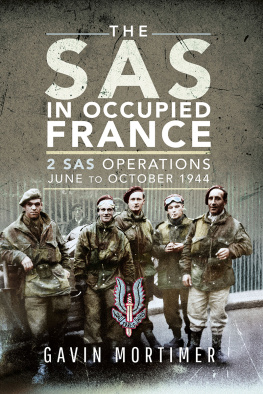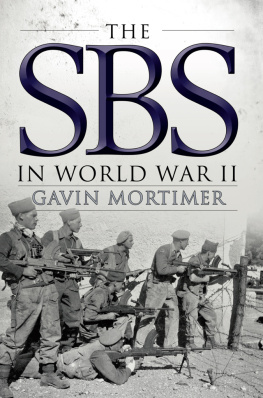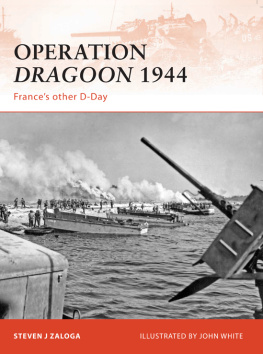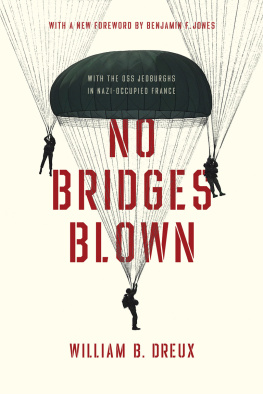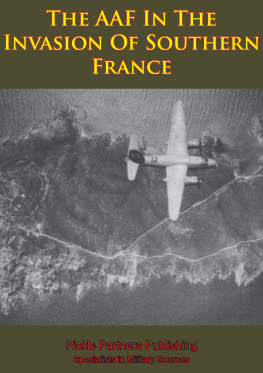Pagebreaks of the print version

The SAS in Occupied France
The SAS in Occupied France
2SAS Operations JuneOctober 1944
Gavin Mortimer
First published in Great Britain in 2023
PEN & SWORD MILITARY
An imprint of Pen & Sword Books Ltd
Yorkshire Philadelphia
Copyright Gavin Mortimer, 2023
ISBN 978-1-52676-958-9
EPUB ISBN 978-1-52676-959-6
MOBI ISBN 978-1-52676-959-6
The right of Gavin Mortimer to be identified as the author of this work has been asserted by him in accordance with the Copyright, Designs and Patents Act 1988.
A CIP catalogue record for this book is available from the British Library.
All rights reserved. No part of this book may be reproduced or transmitted in any form or by any means, electronic or mechanical including photocopying, recording or by any information storage and retrieval system, without permission from the Publisher in writing.
Pen & Sword Books Ltd incorporates the imprints of Aviation, Atlas, Family History, Fiction, Maritime, Military, Discovery, Politics, History, Archaeology, Select, Wharncliffe Local History, Wharncliffe True Crime, Military Classics, Wharncliffe Transport, Leo Cooper, The Praetorian Press, Remember When, White Owl, Seaforth Publishing and Frontline Publishing.
For a complete list of Pen & Sword titles please contact
PEN & SWORD BOOKS LTD
47 Church Street, Barnsley, South Yorkshire, S70 2AS, England
E-mail:
Website: www.pen-and-sword.co.uk
or
PEN & SWORD BOOKS
1950 Lawrence Rd, Havertown, PA 19083, USA
E-mail:
Website: www.penandswordbooks.com
This work is dedicated to Sergeant Gerald Davis, and the men of Moussey, who never talked.
How to use this book
This is a book for the committed battlefield tourist, and it might be an idea for those who cant speak a word of French to brush up on the basics! Unlike the majority of the First and Second World War sites, such as Thiepval, Arras and Normandy, the locations in this book are remote and rarely visited by battlefield tourists. Thats hardly a surprise given that the SASs task in the summer of 1944 was to conceal themselves in thick forests and deep ravines and to sally forth to wage guerrilla war on the Germans. In order to help you reach these sites, Ive included the GPS coordinates in most cases. To pinpoint the exact location, on your computer open Google Maps and type in the coordinates that are shown as Decimal Degrees (DD): i.e., 47.82479, 2.484187 . A red pin will appear on your screen at the site.
Areas such as the Vosges and Bourgogne are stunning in their scenery and the people are warm in their welcome but few speak much English, so be warned.
One other word of warning concerns hunters. You will be going into regions rich in game, and hunting is a massive pastime in France. The season begins in the middle of September and ends in February, and unfortunately French hunters have a well-deserved reputation for being trigger-happy. If you see a sign saying Attention! Chasse en cours , then a hunt is in progress so steer clear.
Another unwanted denizen of the forests in France are ticks but the forestry commission is diligent in posting signs alerting walkers to their presence Attention aux tiques .
There are plenty of villages close to the sites mentioned in this book but they are sleepy, and what shops there are will be closed in the afternoons. Restaurants and cafs are few and far between outside the major towns but I have listed some of those where I found them. There are several good Second World War museums, which I have also listed, with some selling guide-books/pamphlets in English, as well as memorabilia connected to the war.
Talking of feet, bring sturdy walking shoes and a decent level of fitness. The SAS and the Maquis chose their camps well, and youll only understand how well once youve trekked through the forest.
Happy hiking and remember, who dares gets the most out of this book.
Acknowledgements
Thank you firstly to those people in France who helped with the research for this book. In no particular order, Arnaud Blond, curator at the Museum of Resistance and Deportation in Lorris, the staff at the Museum of Resistance in Saint-Marcel, particularly Tristan Leroy and Christophe Guilloue t, who kindly granted me permission to reproduce ten photos from the wonderful collection of Henri Costa. I am grateful also to Michel Diey and everyone at the Association des Amis du Chtillonais, Gerard Villemin, who was such a diligent and knowledgeable guide around the Vosges, as well as Maryvonne Arnoux-Bau, the former mayor of Le Mont, who not only showed me the location of the DZ onto which Henry Druce and his men landed, but also hosted me to lunch.
Sandy and Margot, my faithful support team, were as patient and tolerant as ever as we journeyed off the beaten track to pinpoint the events described in this book. Merci, mes belles!
Several villagers of Villaines-les-Prvtes went out of their way to show me some of the exact locations of the action during the battle on that August evening, including the spot where Len Rudd lost his life. In Bierry-les-Belles-Fontaines I had the pleasure of meeting Maurice Rousselet, who shared his memories of life as a teenager in the village during the Occupation. Sadly, Maurice has since died, and also no longer with us is Henri Poirson. I had the privilege of meeting Henri in June 2016 and listening to his account of his time in the Maquis, including welcoming Henry Druces advance party onto the DZ. Over a beer Henri spoke of his time in Auschwitz, rolling up one sleeve to show me his 92-year-old arm and the tattooed number still visible on his skin.
Jane Wadham, the daughter of Len Owens, whose courage, professionalism and sang-froid during Operation Loyton were so invaluable, provided me with much information about her remarkable father. Thank you, also, to Danielle Meier, for putting me in contact with Jane.
There are many corners of French fields in which there rests an SAS soldier. Most are remote and far removed from the large battlefield cemeteries of Normandy and the Somme. But thanks to the loving assiduity of such villages as Moussey, Moyenmoutier, Recey-sur-Ource and Villaines-les-Prvtes the sacrifice of these brave young men endures.
Finally to the SAS veterans featured in this book, some of whom I interviewed and got to know well over the course of several years. Most are long since dead but their exploits endure. To Tony Greville-Bell, Arthur Thompson, Charlie Hackney, Bob Walker-Brown, Alex Robertson, Charlie Radford, Lew Fiddick, Harry Vickers, Bill Robinson and Henry Druce: You were men.
Introduction
There have over the years been many inaccuracies and untruths written about the 2nd Special Air Service Regiment, some of them the fault of the regiments founder, David Stirling. In fact the SAS was as much the brainchild of Davids eldest brother Bill as it was his. During the war the joke among the soldiers was that SAS stood for Stirling and Stirling, and in his 1948 memoir, Winged Dagger , the superb 2SAS officer Roy Farran described the brothers as the pioneers of the SAS idea.
In the semi-autobiographical The Phantom Major , published in 1958, David Stirling was quoted as saying he was captured in January 1943 in an attempt to drive north through Tunisia to become the first unit from the Eighth Army to link up with the First Army, of which Bill was a component, having recently arrived on the First Army Front with the 2nd SAS Regiment.

